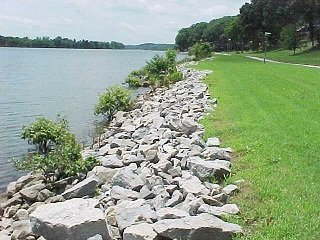 Riprap is one of the most identifiable and commonly fished spots of a lake, as it’s a structure that tends to hold bass throughout the year. If you’re on the lake and you come across riprap, my advice is to fish it. Today, we’ll look at a few tips to help you with this endeavor.
Riprap is one of the most identifiable and commonly fished spots of a lake, as it’s a structure that tends to hold bass throughout the year. If you’re on the lake and you come across riprap, my advice is to fish it. Today, we’ll look at a few tips to help you with this endeavor.
Riprap is a man-made structure consisting of large chunks of rocks or limestone that placed along the shore to prevent erosion. It’s commonly found near bridges, dams, entrances to marinas or harbors, and private shorelines. Bass situate in these areas year-round because of the depth options available to them. This also means they can move shallow to warm themselves or eat, or they can escape a little deeper, if necessary, to protect themselves from weather or predators.
Shallow and gradually sloping riprap banks can be great during early Spring and late Fall. Rocks retain heat and maintain that heat very well, so during these cooler times of the year, bass and baitfish alike can feed in these warmer areas throughout the day.
Bass will also hold on shallow riprap during the Summer, but more on the steeper banks. They’ll move shallow to feed on crawfish and minnows in the early morning hours, but then they’ll retreat back to deeper, cooler water once the sun gets hotter.
There are some key locations within the riprap that you’ll want to seek out and focus your efforts. For example, each section of riprap will have underwater points that serve as staging areas for bass. You can use your electronics, or a search lure, to locate these spots. Furthermore, where the rocks end can also be an excellent place for bass to hold. Lastly, any creek channels swinging near the riprap should be a primary target. You can fish the entire channel with great results, as well.
Crankbaits are great riprap lures. Crawfish color patterns are ideal during the Spring, while shad patterns will produce strikes during Summer. Crankbaits allow you to fish a variety of depths quickly and thoroughly, and their noise-making collisions with the rock will attract fish. Jerkbaits fished parallel to the riprap are also a good choice, especially when the water temperature is cooler, in the 50 to 60-degree range. I’ve also had good luck with soft plastics like worms, grubs, and creatures—typically rigged weedless. They allow me to pick the area apart once I’ve located the strike zone. Finally, if the water is a little dirty and the bass situated shallow, jigs are the way to go.
Many people hear anglers toss around the term “riprap” and they’re not quite clear what it means. Hopefully, the tips outlined above will clear up any confusion and help you target riprap more effectively the next time you hit the water!








